The Holocene Mass Extinction Part 5: The Quaternary Extinction
Part 1, Part 2, Part 3, Part 4
Up until now in this series we've been talking about the recent past. Now we're going to travel back in time a little ways. 132,000 years, in fact. Long, long before recorded history but still well within the lifespan of the human race. We're going to talk about the Quaternary Extinction- humanity's first go at killing everything.
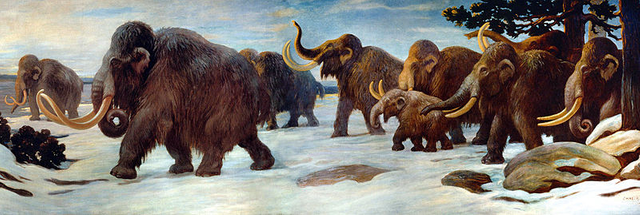
Woolly Mammoths Near the Somme, a mural by the incomparable painter of prehistoric animals, Charles R. Knight. The last woolly mammoths, living on an isolated island in the Arctic Ocean, died off 4,000 years ago, around the time of the building of the pyramids of Egypt. Most went extinct around 4,000 years before that, however. [Image source]
Between 130,000 BCE and 22,000 BCE, species of megafauna- specifically, mammals over 40 kg- started going extinct. It started in Africa, and was relatively minor (only relatively, mind you) at first. 16% of all Subsaharan megafauna was driven extinct by it. In Asia, 52%. In Europe, 59%. In Australia, Southern Asia, and Oceania, 71%. In North America, 74%. In South America, 82%. Notice anything familiar about that pattern? It's the order in which Homo Sapiens settled the continents. That 22,000 BCE figure is when humans started colonizing the Americas, the last continents to be settled. (Antarctica still hasn't been settled, we're just visitors there.)
While there's been some dispute about the exact relationship, it's hard to believe that humans had nothing to do with a mass extinction that almost precisely followed the pattern of their outward migration. How did they accomplish it? Well, that was what the first two posts in this series were about. We're a monstrously effective invasive species.
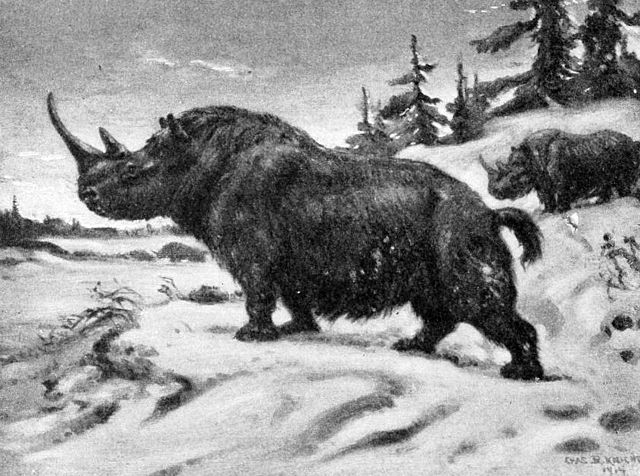
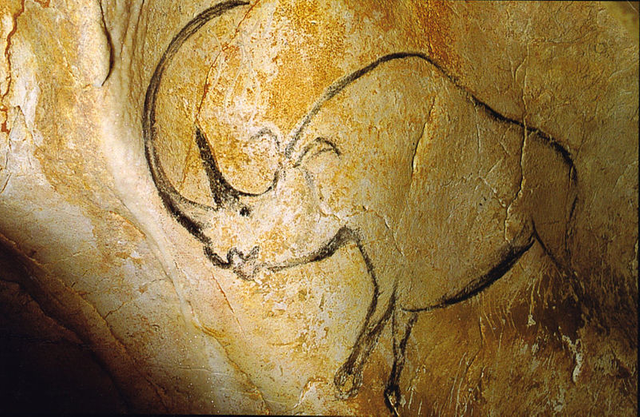
Top: A reconstruction of the woolly rhinoceros by Charles R. Knight. [Image source]
Bottom:A 30,000 year old cave painting from Chauvet Cave in France depicting a woolly rhinoceros. The woolly rhinoceros went extinct around 8,000 years ago. [Image source]
There were three main hypotheses about how the mass extinction occurred. The first claimed that humans weren't responsible, and that it was the end of the last ice age that did it. Since many of the species in question survived multiple ice ages and the dates often don't match up, that hypothesis has been, to a great extent, left by the wayside. The second claimed that the extinction of mammoths did the trick. They were a keystone species that dominated ecosystems around them. On their death, the huge grasslands of the Pleistocene were rapidly replaced with extensive birch forests, which both altered the ecosystem and were quite vulnerable to huge forest fires. The problem with that, of course, is that species went extinct far from the range of mammoths. The third and most plausible, of course, is that humans killed them off. (There are some less plausible hypotheses, like that of a meteor hitting the Earth, but these often lack evidence to the point of being labeled as crackpot.)
There are a few ideas about how humans did the trick. Originally the theory was that humans just massively overkilled everything, but that theory had a few issues. Those issues have been resolved by recent population dynamics simulations, which show that relatively low numbers of deaths over a period of time can wipe out slow breeding species that invest a lot of energy into each of their young. I talked about this in the first post in this series. As for the mammoth grassland/birch forest hypothesis- it's hardly incompatible with all of this, and could definitely have helped everything along.
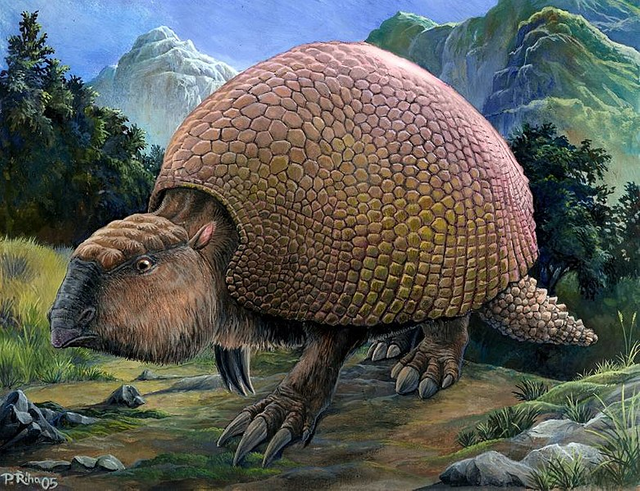
An artist's conception of a glyptodon, a 1 ton extinct armadillo. Their cousins, the glyptodonts (don't get them confused) could reach sizes well over two tons. Their extinction coincided with the arrival of humankind in South America. [Image source]
Here's where we need to start asking ourselves some important questions. First off, does it make sense to divide up the Quaternary and Holocene mass extinctions? Both are human caused, after all. While there does seem to have been something of a lull in extinctions between the two, the period still had a much higher extinction rate than the normal background rate. Next, how should we understand our responsibility for the Quaternary Extinction, given how long ago it occurred?
All of these questions are tied up in the Anthropocene debate. Growing numbers of geologists have begun to argue that we've entered into a new geological era- one dominated and characterized by human influence. These geologists have dubbed this era the Anthropocene. (Other scientists participate too, but only on the sides- geologists have firm control over the geological time scale, and don't readily let others play with it.) There's a ton of debate about when to set the beginning of the Anthropocene, and the various dates set really say a lot about the priorities and ideas of those behind them.
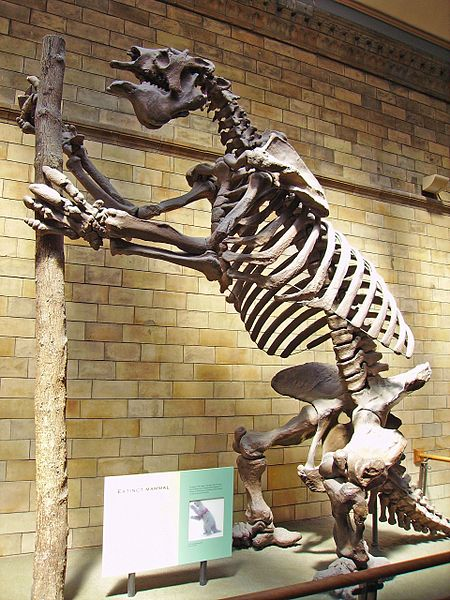
Megatherium, a sloth the size of an elephant. Driven extinct by humans during the Quaternary Extinction. [Image source]
There are a few different starting points listed for the Anthropocene. From youngest to oldest:
- The detonation of the first atomic bomb. This has the advantages of leaving a clear signature in the geological record, as there will be a distinctly higher radioactive material count in all rocks deposited during this time.
- The beginning of the industrial revolution. Though the damage done to the global ecosystem by humanity was bad enough before, it began getting worse at a much more rapid pace during the industrial revolution.
- The beginning of agricultural civilization. Similar arguments apply here as to the industrial revolution.
- The migration of humanity out of Africa and the Quaternary extinction. This is really the beginning of the pattern we just see magnified by agriculture and industry. This is when we began resculpting landscapes, wiping species out, and warping ecosystems.
All of the above have their own proponents. I personally favor the Quaternary extinction event as the beginning of the Anthropocene- it helps us keep in mind that what is occurring now is, in a great many ways, simply the continuation of a pattern long predating history. By thinking about the Quaternary and Holocene extinctions as one continuous process, it might help better understand both how we shape and how we fit into our world.
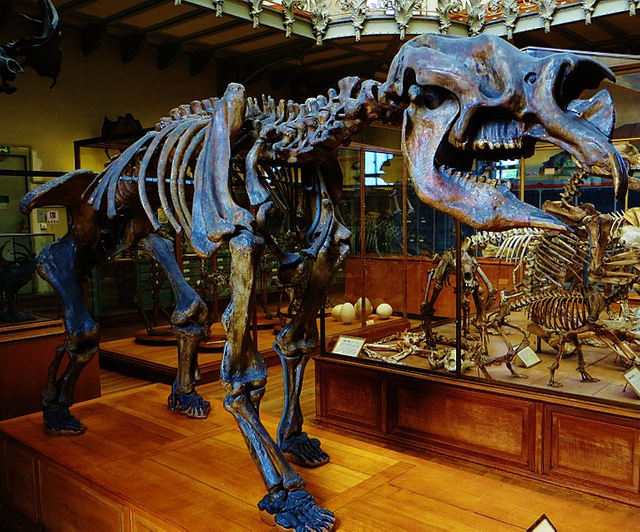
Diprotodon, the largest marsupial to ever live. Its closest living relatives are the koala and the wombat. Diprotodon was driven extinct around 50,000 years ago, when humans first settled Australia. [Image source]
Bibliography:
The Sixth Extinction, by Elizabeth Kolbert
The Song of the Dodo, by David Quammen
Time's Arrow, Time's Cycle, by Stephen Jay Gould
https://en.wikipedia.org/wiki/Quaternary_extinction_event
https://en.wikipedia.org/wiki/Holocene_extinction
https://en.wikipedia.org/wiki/Woolly_mammoth
https://en.wikipedia.org/wiki/Woolly_rhinoceros
https://en.wikipedia.org/wiki/Glyptodon
https://en.wikipedia.org/wiki/Megatherium
https://en.wikipedia.org/wiki/Diprotodon
https://en.wikipedia.org/wiki/Anthropocene
https://en.wikipedia.org/wiki/Pleistocene_megafauna
https://en.wikipedia.org/wiki/Extinction_event

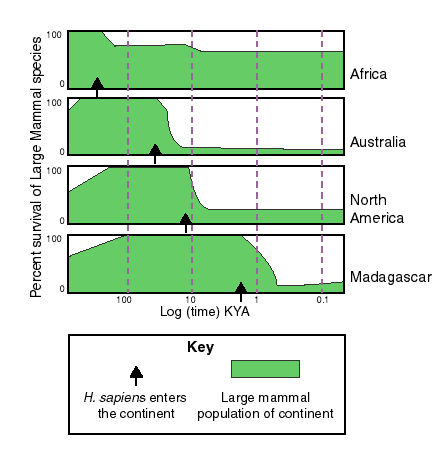
Your post has been personally reviewed and was considered to be a well written high quality article!
You received a 60% upvote since you are a member of geopolis.
To read more about us and what we do, click here.
https://steemit.com/geopolis/@geopolis/geopolis-the-community-for-global-sciences-update-1
If you do not want us to upvote and comment on your posts concerning earth and earth sciences, please reply stop to this comment and we will no longer bother you with our love ❤️
Another excellent post.
We, as a species, have largely done more harm than good. We're cutting down forests and destroying more and more ecosystems (beyond forests) each day. It's sad to see.
One of the biggest ways I think we'll make species go extinct is plastic. You can go to the gyres in the oceans and see huge pools of plastics spinning in the middle of them, it's sad to see and can also make one angry if they love the ocean and its animals like I do. Some scientists predicted that by the year 2050 there will be more plastic than fish in the ocean (by weight). That is with just today's use (I think the study was conducted in 2016 though), that is sure to decrease every year since the population rises and we keep buying plastic products, not recycling, and disposing of them the wrong way.
Sorry, I went on a little tangent.
It was a good tangent, though!
I can imagine some geologist (not exactly the human...) in 5 MY future, explaining the students: This is K-T layer and this is the plastic age layer.
Great post and good luck!
There's actually a lot of study right now going into what is going to happen to plastic being deposited in sediments bound to become rocks! They'll... be weird, certainly. Much of it will likely turn to oil. And thanks!
Really interesting once again! great work on the series. One small question: under the pictures of the woolly rhinoceros, it says the top picture is of a woolly mammoth? because that would be the strangest mammoth I have seen by now 😉
Thanks, nice catch! Fixing that now.
Another facinating read. I know I'm mixing science with science fiction, but it made me think of that scene in The Matrix where Agent Smith is talking about the human race and describes it as a virus, consuming all the natural resources etc.. in their path
That was one of the better written monologues in that series, definitely!
I must agre with the “Originally the theory was that humans just massively overkilled everything”
And I’m afraid that’s what is happening today as well.
Is this just another cycle of animal extinction caused mainly by humans?
Great post!
Resteemed!
well done!
Your Post Has Been Featured on @Resteemable!
Feature any Steemit post using resteemit.com!
How It Works:
1. Take Any Steemit URL
2. Erase
https://3. Type
reGet Featured Instantly – Featured Posts are voted every 2.4hrs
Join the Curation Team Here
Excellent story, it is fascinating to go back to the past and know those things that we ignored.
@originalworks
The @OriginalWorks bot has determined this post by @mountainwashere to be original material and upvoted it!
To call @OriginalWorks, simply reply to any post with @originalworks or !originalworks in your message!